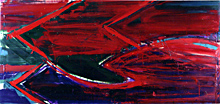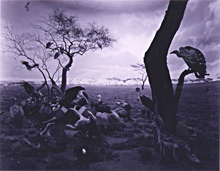6b
東京シミュレーショニズム前夜
The Eve of Tokyo Simulationism
【本文確定】
1980年代後半の東京では、美術界の内部が保守化していく一方で、外部ではポップ化の新動向が生まれました。
美術界内部では、中村一美や岡崎乾二郎がBゼミ(という美術学校)の講師として、当時生徒だった丸山直文らに影響を与えていました。雰囲気としては、「パルコや新表現主義はダメ」だったそうです。その代わりに季節外れのモダニズムとして、アメリカ抽象表現主義風のフォーマリズム絵画が描かれる文脈が存在しました*6b1。保守化したこの状況は、1970年代末の絵画回帰におけるシステミック・ペインティングの系譜に、表現主義的な力学が働いていったものだったかもしれません*6b2。そして1990年代以後も、美術内美術の一部の動向として存続することになります。
1987年、西武美術館で峯村敏明の監修による「もの派とポストもの派の展開-1969年以降の日本の美術」展が開催されました。展覧されたのは1970年代のもの派とポストもの派、1980年代前半の「ポストもの派の洗練」ならびに「ジャンルとしてのインスタレーション」(「超少女」含む)の作家たちでした。これにより1980年代は、批判的継承とはいえども1970年代からの連続とみなされ、重要な新機軸の出現は無かったこととなりました*6b3。むしろ杉本博司や宮島達男ら、河原温に続くコンセプチュアル系の作家の海外での活躍が新鮮でした。またバブル景気が始まり、国内よりも海外最新の現代美術に関心が向けられました*6b4。
「もの派とポストもの派の展開」展は、もの派を基軸とした日本美術史総括でした。一方、1986年の千葉成夫の著書『現代美術逸脱史 1945-1985』(晶文社)は、美共闘を基軸とした日本美術史総括だったといえます。両者には相違点もありましたが、パルコや新表現主義を排除した日本美術史という点では一致していました。ところで1986年には、ロンドン帰りの中村信夫の著書『少年アート』(スケール)も出版されました。その本の中では日本のパルコや、日本と世界の新表現主義は、皮相的な「アート・シーン」であるとして切り捨てられていました。そして肝心の「アート・ワールド」は、日本には存在しないと断じられていました*6b5。これに衝撃を受けた東京藝術大学の学生たちが1991年に開始したのが、「東京ポップ」(あるいは「ネオ・ポップ」、「東京シミュレーショニズム」)と後に呼ばれる動向です*6b6。それまでは「西高東低」が続きました。
美術界外部では、アンチ・ハイアート気分を保持したまま、保守化したイラストレーションにも距離を置くスタンスの画廊が出現しました。1986年4月、東京渋谷にオープンしたギャラリー・アートワッズです。開廊第1回展は、数年分の日グラ入選作ほかを展示した私の初個展でした。1986年7月、東京工作クラブ初個展。東京工作クラブは当時19歳の美大生だった久木田知子と前田さゆり[SMO]の女子2名のユニットで、デビュー時にはすでに、タッチを消し色数を限り形態を明確かつ没個性的とした完璧なポップ・アート様式が完成していました。1986年11月、私の第2回個展の開催。私は芸術至上主義的な厚塗りのアクリル絵画を展示しましたが、イラストレーションの側からは美術という外部と見なされ、美術の側からはイラストレーションという外部と見なされるという肩書不在状態になりました*6b7。
東京工作クラブの男版を作ろうと言って1988年に結成されたユニットが、ヒロ杉山[竹屋すごろく]と谷田一郎の男子2名から成る近代芸術集団(Neo Art Group)でした。作風は確信犯的なドイツ風ポップで、カツラやウンチといったモチーフが、大画面に堂々と描かれていました。ほかに、この時期にポップな作風を示した作家としては、末続あけみ、井口真吾、山本タカト、都築潤、沼田元氣らがいます。
1989年10月、私は図版も文字も全て手書きの美術史書『近代美術史テキスト-印象派からポスト・ヘタうま・イラストレーションまで』を刊行しました。そこでは反芸術の帰結であるシミュレーショニズムを「美術が不要になる日」と解説し、ヘタうまを生んだ日本のイラストレーションを世界のポストモダニズムの最終形と位置づけました。その主旨は理解されませんでしたが*6b8、同書はただちに『美術手帖』誌ほかで好意的に紹介されました。手描き図版も含め、同書全体が美術史のシミュラクル作品となっていた点が面白がられたのです*6b9。そして同書の主旨にしたがって私自身は1990年1月、シミュレーショニズムの徹底として主体性を否定した受注芸術家としてのイラストレーターを名乗り、絵筆をパソコンのマウスに持ち替えて作風を転換しました*6b10。
1990年1月、イラストレーションを専門に扱う東京青山のHBギャラリーで、私は全作コンピューターグラフィックス(CG)の個展「大ボケツ」を行いました。当時目新しかったパソコン上でヘタうまとテクノの融合を目指し*6b11、中解像度のビットマップCGでジャギー(ギザギザ)を強調した確信犯的なその作風は*6b12、「バカCG」と呼ばれました*6b13。1990年8月号の『イラストレーション』誌上公募展「ザ・チョイス」では、審査員のスージィ甘金の作品のパロディをバカCGで提出して入賞しました。この時の、オリジナルのないCGという形式でオリジナルでない内容を描くという方式を敷衍して、1991年3月、「ハマルコン ’91」をギャラリー・アートワッズで、「第5回東京イラストレータラーズソソサエアエティ展」をHBギャラリーで同時開催し、両ギャラリーをシャトルバスで結びました。前者は1990年に幕張メッセで開催された大規模国際展「ファルマコン ’90-現代の美術展」の、後者は1989年に開始された「東京イラストレーターズソサエティ展」のアプロプリエーションで、ダブル個展全体に「パロディ・贋作」というコピーを冠しました。私は国内外の美術家とイラストレーターの総勢107名に成りすまし、美術とイラストレーションの両ジャンルをシャトルして、コンピューターデータのハイパーリアルな等価複製性によって、量が質に転ずるレディメード的ポップ・アートを自任しました*6b14。
In the late 1980s, the inside of (within) the art world in Tokyo was largely on the decline accelerated by its conservatism, however, on the other hand, a new trend of pop started outside of the art world.
【注の番号一致せず、第一版ママ】Within the art world, Nakamura Kazumi and Okazaki Kanjiro, instructors at B Seminar Schooling System, were influencing their students, such as Maruyama Naofumi*6b1. They denied the Neo-Expressionism and the Parco style . When one starts to build up painting in Japan, s/he must begin painting from the formalism. Thus, painting in the style of abstract expressionism was made. This tendency has continued since the return to paintings in the latter half of 1970s by Usami Keiji and others.
【注の番号一致せず、第一版ママ】In 1987, there was an exhibition "Art in Japan since 1969 / Mono-ha and Post Mono-ha" supervised by Minemura Toshiaki at Seibu Art Museum. Art works exhibited at this Exhibition were made by the artists of Mono-ha and Post Mono-ha of the 1970s and the Refinement of the Post Mono-ha and Supergirls, who were active in the early part of the 1980s. Since this exhibition, the era of the 1980s is regarded as just a continuation of the era of the 1970s, therefore an epoch-making new trend was considered not to have appeared. It was rather freshly impressive that Sugimoto Hiroshi and Miyajima Tatsuo and others, the type of conceptual art artists after Kawara On, played an active role in the overseas art world. When the bubble economy started, the latest overseas modern art got more attention than the domestic art*6b2.
【注の番号一致せず、第一版ママ】Although the exhibition "Mono-ha and Post Mono-ha" was a summary of the history of Japanese art which focused on Mono-ha, the "Contemporary Art in Japan 1945-1985 -- Art as a Deviation," written by Chiba Shigeo was a summary focused on Bikyoto. There were some differences between the two, but they had a concurrence in supporting the Japanese art history which excluded the Parco line and the Neo-Expressionism. In 1986, Nakamura Nobuo, who returned from London, published a book, "Shonen Art (Relax Contemporary Art)." In his book Nakamura simply slashed the Parco line and the Japanese and international Neo-Expressionism as a superficial "art scene" and clearly declared that there was no "art world" being crucial in Japan. The students of Tokyo National University of Fine Arts and Music who deeply influenced by his argument started a movement in 1991 that was to be called "Tokyo Pop" later*6b3. Until the movement began, the phenomenon of the so-called "High in Kansai, Low in Kanto" continued.
【注の番号一致せず、第一版ママ】Meanwhile, an art gallery, which maintained its anti-high art style and kept its distance from conservative illustration, started business outside the art world. It was Gallery Art Wad's in Shibuya which opened in April, 1986. The first opening exhibition at the gallery was my first solo exhibition displaying the several years stock of my winning works from the Nippon Graphics Exhibitions and others. In July 1986, "Tokyo Kousaku Club" had its own first exhibition. The club was made up of only two 19 year old female art college students, Kukita Tomoko and Maeda Sayuri [SMO]. They had already completed perfect pop art style at the time of their debut by erasing "touch," limiting colors and making object shapes clear and rejecting individuality. In November of the same year, I had my solo exhibition for the second time where I exhibited a series of thick acrylic paintings as art for art's sake. The result was that illustrators labeled my works as fine art which meant outside, and on the contrary, the fine art side considered my works as illustrations which also meant outside.
【注の番号一致せず、第一版ママ】Hiro Sugiyama [Takeya Sugoroku] and Tanida Ichiro formed "Neo Art Group" in 1988 as a male version of "Tokyo Kousaku Club." Their style was German Pop as crime of conscience. They painted wigs and toilets on a big screen without hesitation. Suetsugu Akemi, Iguchi Shingo, Yamamoto Takato, Tsuzuki Jun and Numata Genki were active in pop style at that time.
【注の番号一致せず、第一版ママ】In October 1989, I published a handwritten art history book with hand-written characters and hand-drawn plates, "Text on Modern Art History: From Impressionist to Post-Heta-Uma Illustration." In this book I commented on Simulationism as "the day Art lost its place" and pointed at the Japanese illustration including the heta-uma as the final form of postmodernism in the world. Though my opinion was not well accepted*6b4, the book was quickly introduced in the art magazine Bijutsu Techo and others with favorable reviews. I believe that the book was well-received because it became a simulacre work of art history as a whole book including my hand written illustrations*6b5. According to the argument I made in my book, I have moved onto the next style of art, calling myself an illustrator who is a made-to-order based artist denying the subject*6b6.
【注の番号一致せず、第一版ママ】In January 1990, I had a solo exhibition, "Huge Grave (Dai Boketsu)" at HB Gallery in Aoyama, Tokyo, which specialized in illustrations. All the exhibits were computer graphics (CG). My objective was to create fusion between Heta-Uma and Techno by using a personal computer that was still novel at that time*6b7. I emphasized the jaggedness on CGs in low resolution. The work was called "Silly CG (Baka CG)" because of its sense of crime of conscience*6b8 *6b9. I got an award from "The Choice," a contest in the August 1990 issue of the "Illustration" magazine. In this work, I made a parody of Suzy Amakane's work by applying of my Silly CG style. Suzy Amakane was the juror. While I was producing made-to-order illustrations in my Silly CG style on order base thereon, I started to make many "reproductive paintings" in the Silly CG style on my own*6b10. In March 1991, I held an exhibition "PHAMARKON '91" at Gallery Art Wad's and at the same time had another exhibition "The Fifth Exhibition of Tokyo Illustratarers Sosocieiety" at HB Gallery. There was a shuttle bus service between these two exhibition sites. The former was an appropriation of the large scale international exhibition "PHARMAKON '90 - Contemporary Art Exhibition" held at the Makuhari Messe in 1990, and the latter was also an appropriation of Tokyo Illustrators Society Exhibition held in 1989*6b11. I named my twin exhibition, "Parody / Counterfeit." While I was pretending to be 107 Japanese and foreign artists and illustrators*6b12, I foncied myself a readymade pop art where quantity changed to quality by computer datas which are possible to replicate many times even without the originals and which shuttle between genres of fine art and illustration*6b13.


